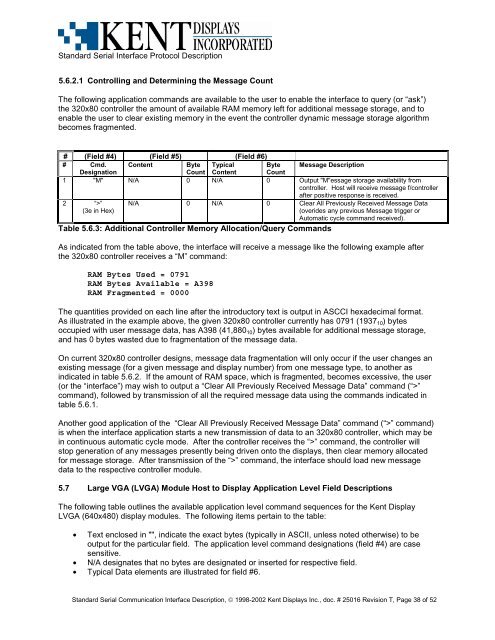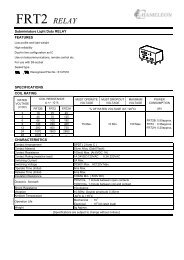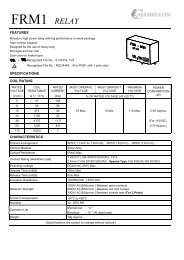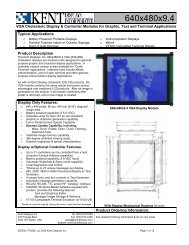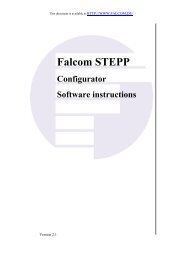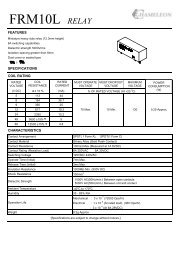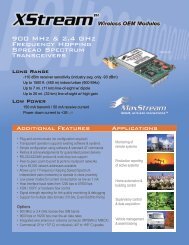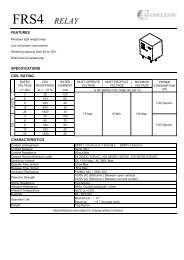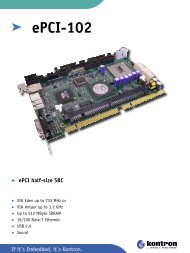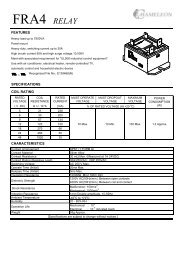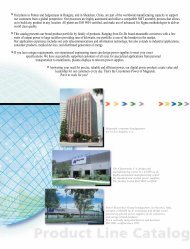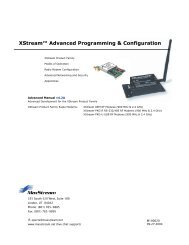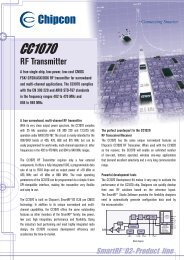STANDARD SERIAL COMMUNICATION INTERFACE and ...
STANDARD SERIAL COMMUNICATION INTERFACE and ...
STANDARD SERIAL COMMUNICATION INTERFACE and ...
Create successful ePaper yourself
Turn your PDF publications into a flip-book with our unique Google optimized e-Paper software.
St<strong>and</strong>ard Serial Interface Protocol Description<br />
5.6.2.1 Controlling <strong>and</strong> Determining the Message Count<br />
The following application comm<strong>and</strong>s are available to the user to enable the interface to query (or “ask”)<br />
the 320x80 controller the amount of available RAM memory left for additional message storage, <strong>and</strong> to<br />
enable the user to clear existing memory in the event the controller dynamic message storage algorithm<br />
becomes fragmented.<br />
# (Field #4) (Field #5) (Field #6)<br />
# Cmd. Content<br />
Byte Typical Byte Message Description<br />
Designation<br />
Count Content Count<br />
1 "M" N/A 0 N/A 0 Output "M"essage storage availability from<br />
controller. Host will receive message f/controller<br />
after positive response is received.<br />
2 “>”<br />
(3e in Hex)<br />
N/A 0 N/A 0 Clear All Previously Received Message Data<br />
(overides any previous Message trigger or<br />
Automatic cycle comm<strong>and</strong> received).<br />
Table 5.6.3: Additional Controller Memory Allocation/Query Comm<strong>and</strong>s<br />
As indicated from the table above, the interface will receive a message like the following example after<br />
the 320x80 controller receives a “M” comm<strong>and</strong>:<br />
RAM Bytes Used = 0791<br />
RAM Bytes Available = A398<br />
RAM Fragmented = 0000<br />
The quantities provided on each line after the introductory text is output in ASCCI hexadecimal format.<br />
As illustrated in the example above, the given 320x80 controller currently has 0791 (1937 10 ) bytes<br />
occupied with user message data, has A398 (41,880 10 ) bytes available for additional message storage,<br />
<strong>and</strong> has 0 bytes wasted due to fragmentation of the message data.<br />
On current 320x80 controller designs, message data fragmentation will only occur if the user changes an<br />
existing message (for a given message <strong>and</strong> display number) from one message type, to another as<br />
indicated in table 5.6.2. If the amount of RAM space, which is fragmented, becomes excessive, the user<br />
(or the “interface”) may wish to output a “Clear All Previously Received Message Data” comm<strong>and</strong> (“>”<br />
comm<strong>and</strong>), followed by transmission of all the required message data using the comm<strong>and</strong>s indicated in<br />
table 5.6.1.<br />
Another good application of the “Clear All Previously Received Message Data” comm<strong>and</strong> (“>” comm<strong>and</strong>)<br />
is when the interface application starts a new transmission of data to an 320x80 controller, which may be<br />
in continuous automatic cycle mode. After the controller receives the “>” comm<strong>and</strong>, the controller will<br />
stop generation of any messages presently being driven onto the displays, then clear memory allocated<br />
for message storage. After transmission of the “>” comm<strong>and</strong>, the interface should load new message<br />
data to the respective controller module.<br />
5.7 Large VGA (LVGA) Module Host to Display Application Level Field Descriptions<br />
The following table outlines the available application level comm<strong>and</strong> sequences for the Kent Display<br />
LVGA (640x480) display modules. The following items pertain to the table:<br />
• Text enclosed in "", indicate the exact bytes (typically in ASCII, unless noted otherwise) to be<br />
output for the particular field. The application level comm<strong>and</strong> designations (field #4) are case<br />
sensitive.<br />
• N/A designates that no bytes are designated or inserted for respective field.<br />
• Typical Data elements are illustrated for field #6.<br />
St<strong>and</strong>ard Serial Communication Interface Description, © 1998-2002 Kent Displays Inc., doc. # 25016 Revision T, Page 38 of 52


